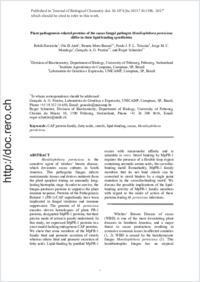Plant pathogenesis-related proteins of the cacao fungal pathogen Moniliophthora perniciosa differ in their lipid-binding specificities
- Darwiche, Rabih University of Fribourg, Switzerland
- El Atab, Ola University of Fribourg, Switzerland
- Baroni, Renata Moro Instituto Agronômico de Campinas, Brazil
- Teixeira, Paulo J. P. L. Laboratório de Genética e Expressão, UNICAMP, Brazil
- Mondego, Jorge M. C. Instituto Agronômico de Campinas, Brazil
- Pereira, Gonçalo A. G. Laboratório de Genética e Expressão, UNICAMP, Brazil
- Schneiter, Roger University of Fribourg, Switzerland
-
17.10.2017
Published in:
- Journal of Biological Chemistry. - 2017, p. jbc.M117.811398
English
Moniliophthora perniciosa is the causative agent of witches' broom disease, which devastates cacao cultures in South America. This pathogenic fungus infects meristematic tissues and derives nutrients from the plant apoplast during an unusually long-lasting biotrophic stage. In order to survive, the fungus produces proteins to suppress the plant immune response. Proteins of the Pathogenesis Related 1 (PR- 1)/CAP superfamily have been implicated in fungal virulence and immune suppression. The genome of M. perniciosa encodes eleven homologues of plant PR-1 proteins, designated MpPR-1 proteins, but their precise mode of action is poorly understood. In this study, we expressed MpPR-1 proteins in a yeast model lacking endogenous CAP proteins. We show that some members of the MpPR-1 family bind and promote secretion of sterols whereas others bind and promote secretion of fatty acids. Lipid-binding by purified MpPR-1 occurs with micromolar affinity and is saturable in vitro. Sterol binding by MpPR-1 requires the presence of a flexible loop region containing aromatic amino acids, the caveolin-binding motif. Remarkably, MpPR-1 family members that do not bind sterols can be converted to sterol binders by a single point mutation in the caveolin-binding motif. We discuss the possible implications of the lipid-binding activity of MpPR-1 family members with regard to the mode of action of these proteins during M. perniciosa infections.
- Faculty
- Faculté des sciences et de médecine
- Department
- Département de Biologie
- Language
-
- English
- Classification
- Biological sciences
- License
-
License undefined
- Identifiers
-
- RERO DOC 305620
- DOI 10.1074/jbc.M117.811398
- Persistent URL
- https://folia.unifr.ch/unifr/documents/306089
Statistics
Document views: 116
File downloads:
- pdf: 168
